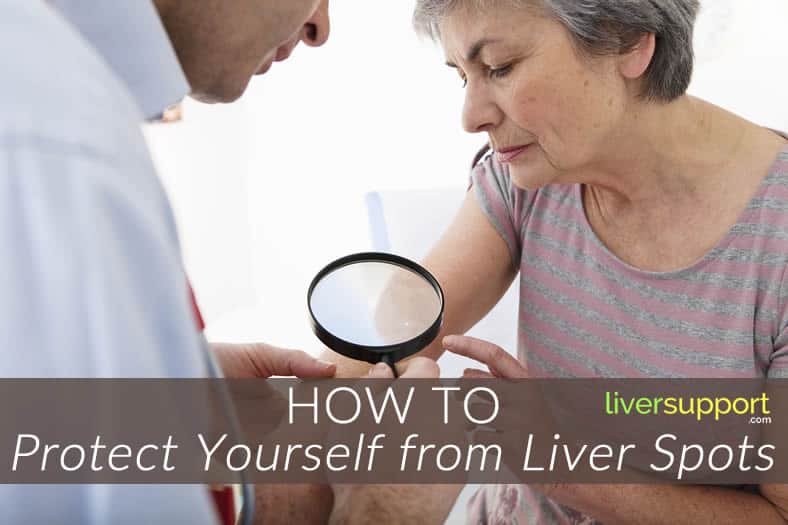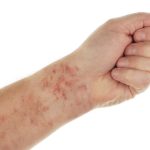
Previous
6 Anti-Inflammatory Foods for Your Liver

Next
Reishi Mushrooms Are Valuable for Liver Health
How to Protect Yourself from Liver Spots
Learn about the association between liver spots, UV radiation, free radicals and liver health. You’ll also discover how to prevent and naturally lighten liver spots.
Typically appearing in adults older than forty years old, age spots are also known by the nickname liver spots. Consequences of repeated sun exposure, liver spots are more of a cosmetic concern than a health hazard. Many medical sources claim that age spots were once believed to be a sign of poor liver function, but modern physicians no longer see a connection between the two. Nonetheless, some holistic-minded practitioners have a broader opinion.
About Liver Spots
Known technically as solar lentigines, liver spots are flat tan, brown or black spots that vary in size and usually appear on the face, hands, shoulders and arms – areas most exposed to the sun. Although they often develop in people with a fair complexion, liver spots can also appear in those with darker skin.
The primary cause of solar lentigines is repeated exposure to ultraviolet (UV) light. UV exposure accelerates the production of melanin, which is the pigment in the skin’s upper layer. The increased production of melanin can lead to a tan and liver spots. Tanned skin is actually a sign of skin damage. UV light exposure damages cells, which releases free radicals. Free radicals are unstable molecules that initiate a domino-type effect that can cause damage to the DNA in cells. Over time, free radicals may cause cellular damage to the skin – such as liver spots.
Liver Spot Prevention
The best way to prevent age spots is to protect your skin from harmful UV radiation. The younger this awareness begins, the better chance of preventing liver spots and skin cancer.
Experts suggest the following four tips for protecting your skin against UV radiation:
- Time of Day – Avoid the sun between 10am and 3pm because the sun’s rays are strongest during this time frame.
- Use Sunscreen – Apply a broad-spectrum sunscreen that protects against UVA and UVB light 30 minutes before going outdoors. Your sunscreen should contain a minimum SPF of 30, and should be reapplied every two hours.
- Shield Your Skin – Cover your skin from direct UV radiation with a broad-rimmed hat and tightly woven clothing. Some clothing has built-in SPF of 40 to 50 that provides additional protection from the sun.
- After Sun – After sun exposure, applying aloe vera or coconut oil can help soothe and repair some damage to skin cells. Coconut oil is rich in antioxidants, which help neutralize free radicals.
Dealing with Liver Spots
In general, liver spots are harmless and don’t require treatment. However, any new skin spots should be evaluated by a physician to rule out melanoma, a serious form of skin cancer.
This is especially true for spots that:
- Are dark in color
- Are rapidly increasing in size
- Have an irregular border
- Contain an unusual combination of colors
- Are accompanied by itching, redness, tenderness or bleeding
Although liver spots are not dangerous, many people choose to address them for cosmetic reasons.
5 Types of Treatments for Liver Spots
- Medications – These include prescription-bleaching creams (hydroquinone) used alone or with retinoids (tretinoin) and a mild steroid. Over several months, these medications may gradually fade the spots. Side effects may include itching, redness, burning or dryness.
- Laser and Intense Pulsed Light Therapy – Typically requiring a series of treatments, these therapies destroy melanin-producing cells without damaging the skin’s surface. Laser therapy has few side effects, but it may result in slight discoloration of the skin.
- Freezing (Cryotherapy) – This procedure applies liquid nitrogen or another freezing agent to liver spots to destroy the extra pigment. Cryotherapy may temporarily irritate the skin and poses a slight risk of permanent scarring or discoloration.
- Dermabrasion – Dermabrasion consists of sanding down the surface layer of the skin with a rapidly rotating brush. This allows a new layer of skin to grow in place of the removed, damaged skin. Temporary redness and scab formation often result from dermabrasion.
- Chemical Peel – Chemical peels apply an acid to burn off the outer layer of skin. Similar to dermabrasion, this allows a new layer of skin to grow in place of the burned, damaged skin. Temporary irritation is likely, and there’s a slight risk of discoloration.
A Natural Way to Lighten Liver Spots
Although immediate and dramatic results may not be seen with the natural remedies described below, these three approaches can also lighten liver spots.
- Oils – Emu oil, coconut oil and/or Vitamin E oil applied topically can help fortify aging skin and fade liver spots.
- Kitchen Staples – Applied topically to the skin, fresh lemon juice, organic buttermilk, raw potato slices or a mixture of apple cider vinegar and onion have all been condoned as home health remedies to restore skin health and lighten age spots.
- Antioxidants – Touted as both a preventative and restorative, antioxidants may help reverse liver spots by stopping the destructive ‘domino’ effect of free radicals on skin cells. Dr. Andrew Weil suggests 250 mg of Vitamin C, 400-800 IU of Vitamin E with natural mixed tocopherols, or at least 80 mg of natural mixed tocopherols and tocotrienols, 25,000 IUs of mixed carotenes and 200-300 micrograms of selenium.
Liver Spots and Liver Health
Although the mainstream medical community does not recognize their connection, liver health might be related to liver spots. According to the liver doctor, Dr. Sandra Cabot, improving liver function is important to prevent and manage skin conditions of any kind – including liver spots. Cabot explains that the liver is the major filter of the blood, clearing it of toxins that can build up in the system. Built up toxins readily create free radicals which promote cell damage in the skin. Thus, a highly functioning liver will reduce the quantity of free radicals in the body, which protects against skin cell damage.
While there are many aspects of maintaining optimal liver health, the following are the most valuable:
- Avoiding alcohol, cigarettes, drugs and other toxins.
- Engaging in regular physical activity.
- Minimizing intake of sugar, trans-fats and chemicals.
- Consuming plenty of fresh, whole foods.
- Eating foods rich in antioxidants and supplementing with antioxidants that benefit the liver.
There is no foolproof recipe for keeping your skin free of unwanted age spots, but there are plenty of strategies to minimize their occurrence and appearance. By combining efforts to keep your liver in the best shape possible with protecting your skin from UV radiation, liver spots will play a less prominent role in your golden years.
Editor’s Note: In addition to containing Vitamin E, Clinical LiverSupport offers Alpha Lipoic Acid – an antioxidant that is effective and used to increase glutathione levels (the body’s principal antioxidant that neutralizes free radicals and detoxifies harmful substances) in the body. It is crucial for those with liver concerns because a compromised liver has difficulty producing glutathione on its own.
http://health.howstuffworks.com/skin-care/problems/beauty/age-spots.htm, Age Spots Overview, Retrieved June 12, 2016, HowStuffWorks, 2016.
http://hubpages.com/style/How-to-Use-Coconut-Oil-for-Age-Spots, How to Use Coconut Oil for Getting Rid of Age Spots Naturally, Retrieved June 12, 2016, HubPages, Inc., 2016.
http://www.drweil.com/drw/u/id/QAA3369, Are Liver Spots Dangerous, Andrew Weil, MD, Retrieved June 12, 2016, Weil Lifestyle, 2016.
https://www.liverdoctor.com/liver-problems/liver-spots/, Liver Spots, Retrieved June 12, 2016, Liver Doctor, 2016.
http://www.mayoclinic.org/diseases-conditions/age-spots/basics/definition/con-20030473, Age Spots (Liver Spots), Retrieved June 12, 2016, Mayo Foundation for Medical Education and Research, 2016.
http://www.totalhealthmagazine.com/Body-Skin-Care/Age-Spots-Liver-Spots-and-How-to-Erase-Them.html, Age Spots (Liver Spots) and How to Erase Them, Flora Stay, DDS, Retrieved June 12, 2016, The Wellness Imperative, 2016.










